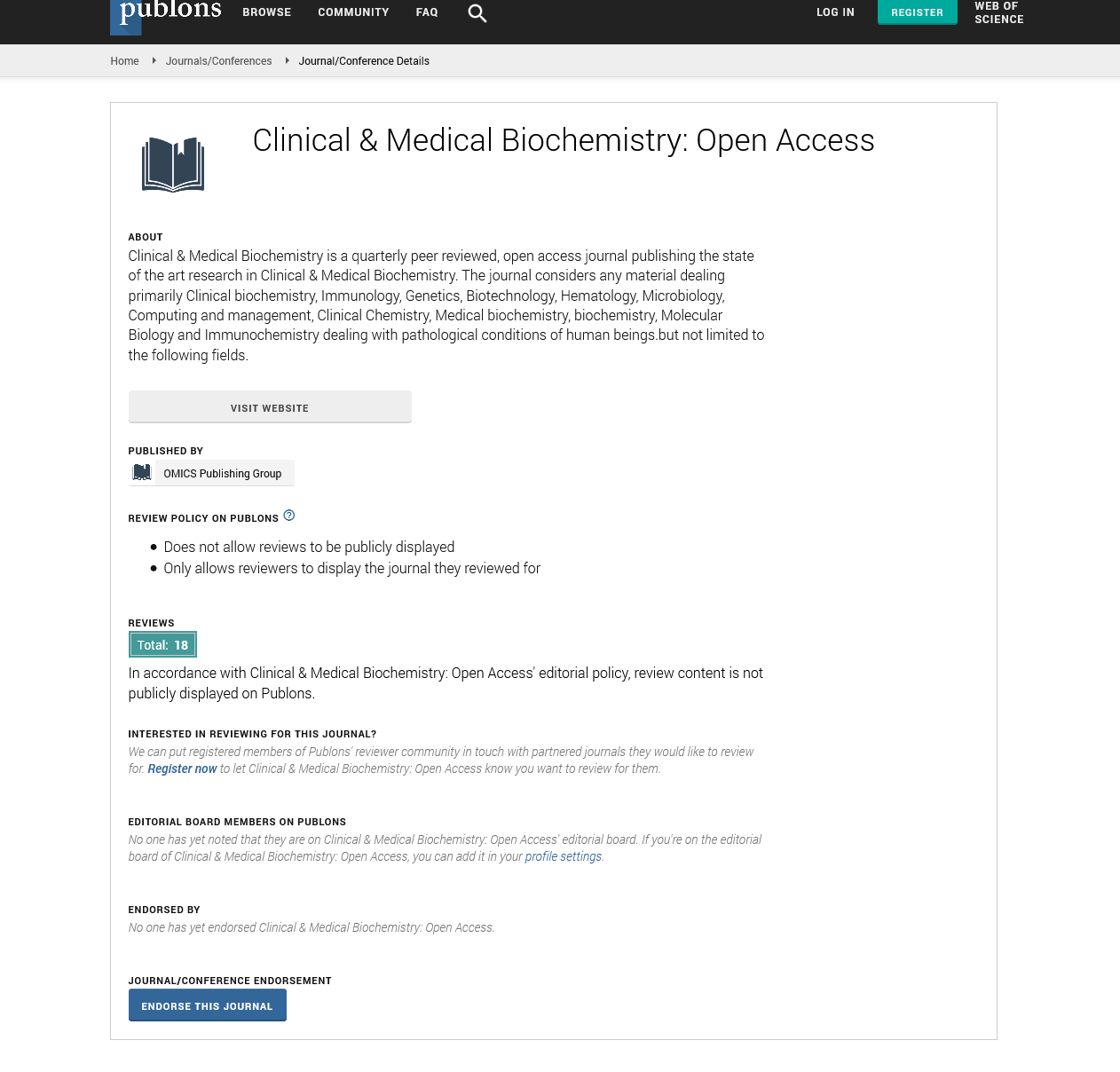Indexed In
- RefSeek
- Directory of Research Journal Indexing (DRJI)
- Hamdard University
- EBSCO A-Z
- OCLC- WorldCat
- Scholarsteer
- Publons
- Euro Pub
- Google Scholar
Useful Links
Share This Page
Journal Flyer

Open Access Journals
- Agri and Aquaculture
- Biochemistry
- Bioinformatics & Systems Biology
- Business & Management
- Chemistry
- Clinical Sciences
- Engineering
- Food & Nutrition
- General Science
- Genetics & Molecular Biology
- Immunology & Microbiology
- Medical Sciences
- Neuroscience & Psychology
- Nursing & Health Care
- Pharmaceutical Sciences
Commentary - (2023) Volume 9, Issue 5
The Potential of Glycoinformatics in Early Diagnosis of Neurodegenerative Disorders
Diogenes Sadras*Received: 01-Sep-2023, Manuscript No. CMBO-23-23158; Editor assigned: 04-Sep-2023, Pre QC No. CMBO-23-23158 (PQ); Reviewed: 18-Sep-2023, QC No. CMBO-23-23158; Revised: 25-Sep-2023, Manuscript No. CMBO-23-23158 (R); Published: 02-Oct-2023, DOI: 10.35841/2471-2663.23.9.190
Description
Neurodegenerative diseases pose a significant global health challenge, with conditions such as Alzheimer's disease, Parkinson's disease, and Amyotrophic Lateral Sclerosis (ALS) affecting millions of people worldwide. Early diagnosis and effective monitoring of disease progression are critical for the development of targeted therapies and improved patient outcomes. Glycosylation is a post-translational modification process where sugar molecules, known as glycans, are attached to proteins. This process plays a vital role in protein structure, stability, and function. Dysregulation of glycosylation has been implicated in various diseases, including neurodegenerative disorders. In this context, glycoinformatics, which involves the computational analysis of glycan-related data, has emerged as a powerful tool for biomarker discovery and the exploration of disease mechanisms. Protein glycosylation is a complex and dynamic process that involves the enzymatic addition of glycans to specific amino acid residues on proteins. The resulting glycoproteins play essential roles in various cellular functions, including cell signaling, immune responses, and protein stability.
N-glycosylation and O-glycosylation. N-glycosylation is the attachment of glycans to the nitrogen atom of Asparagine (N) residues in the protein's amino acid sequence. This process occurs in the endoplasmic reticulum and Golgi apparatus and involves a series of enzymatic reactions. The core N-glycan structure consists of a specific arrangement of glucose, mannose, and N-acetylglucosamine (GlcNAc) molecules. N-glycosylation can significantly impact protein folding, stability, and interactions with other molecules. Alterations in N-glycan composition have been associated with various diseases, including cancer and neurodegenerative diseases. Oglycosylation, in contrast, involves the attachment of glycans to the oxygen atom of Serine (S) or Threonine (T) residues. This process primarily occurs in the Golgi apparatus and is initiated by the addition of N-Acetylgalactosamine (GalNAc) to the protein substrate. O-glycosylation plays a vital role in cell adhesion, signaling, and immune responses. Dysregulation of Oglycosylation has also been implicated in neurodegenerative diseases. Protein glycosylation plays a significant role in neurodegenerative diseases. Abnormal glycosylation patterns have been observed in various proteins associated with these conditions. Alzheimer's disease is characterized by the accumulation of Amyloid-Beta (Aβ) plaques and tau protein coils in the brain. Both Aβ and tau proteins undergo glycosylation, which can influence their aggregation and toxicity.
Glycosylation of Aβ peptides can affect their solubility and aggregation propensity. Aberrant glycosylation of Aβ has been associated with increased plaque formation and neurotoxicity. Tau proteins are abundant in neurons and play a vital role in microtubule stabilization. Hyperphosphorylated and glycosylated tau proteins can form neurofibrillary coils, a distinctive feature of AD pathology. Parkinson's disease is characterized by the accumulation of alpha-synuclein aggregates, known as Lewy bodies. Alpha-synuclein is a glycosylated protein, and alterations in its glycosylation pattern may influence its aggregation and toxicity. ALS is a neurodegenerative disease characterized by the progressive degeneration of motor neurons. Aberrant glycosylation of the Protein Superoxide Dismutase 1 (SOD1) has been implicated in ALS pathogenesis. Glycoinformatics is a rapidly evolving field that utilizes computational methods and tools to analyze and interpret glycan-related data.
Glycoinformatics relies on comprehensive databases of glycan structures. Mass spectrometry is a powerful analytical technique used to identify and quantify glycans on proteins. Glycoproteomics, a subset of proteomics, focuses on the study of glycosylated proteins and their modifications. Bioinformatics tools enable the analysis of glycan data in large-scale experiments. Machine learning algorithms and data mining techniques can identify patterns and associations within glycan datasets, aiding in biomarker discovery and disease classification. Glycoinformatics tools enable the identification of specific glycan structures that are associated with neurodegenerative diseases. These glycans can be detected in various biological fluids, including cerebrospinal fluid and blood plasma, making them potential non-invasive biomarkers for disease diagnosis. Glycan profiles may change as neurodegenerative diseases progress. Glycoinformatics can track these changes, allowing for the development of biomarkers that reflect disease stage and severity. Such biomarkers can aid in patient stratification and treatment monitoring. Understanding disease-specific glycosylation patterns can inform the development of targeted therapies.
For example, drugs that modulate glycan processing enzymes could be used to normalize glycan profiles and potentially slow disease progression. Recent advancements in glycoinformatics have expanded our understanding of glycosylation in neurodegenerative diseases and accelerated biomarker discovery efforts. This has facilitated the identification of disease-specific glycan biomarkers in neurodegenerative diseases. Machine learning and artificial intelligence algorithms are increasingly applied to glycoinformatics data. These tools can identify complex patterns within glycan datasets and predict disease outcomes with high accuracy. Access to well-characterized patient samples, including cerebrospinal fluid and blood, is essential for biomarker discovery. Ethical considerations and sample quality can present challenges in obtaining such samples. Identified glycan biomarkers must undergo rigorous validation in independent cohorts before clinical implementation. Regulatory approval and adoption by the medical community are critical steps in translating glycan biomarkers into clinical practice.
Conclusion
Protein glycosylation and glycoinformatics have emerged as potential approaches for novel biomarker discovery in neurodegenerative diseases. Aberrant glycosylation patterns are associated with disease pathology, and glycoinformatics tools enable the identification of disease-specific glycan biomarkers. These biomarkers have the potential to revolutionize early diagnosis, disease monitoring, and targeted therapy development. As technology and computational methods continue to advance, glycoinformatics will play an increasingly primary role in solving the complexities of neurodegenerative diseases and improving patient outcomes.
Citation: Sadras D (2023) The Potential of Glycoinformatics in Early Diagnosis of Neurodegenerative Disorders. Clin Med Bio Chem. 9:190.
Copyright: © 2023 Sadras D. This is an open-access article distributed under the terms of the Creative Commons Attribution License, which permits unrestricted use, distribution, and reproduction in any medium, provided the original author and source are credited.

